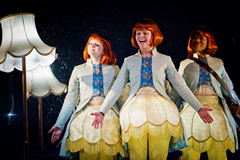 English Touring Opera’s revived production of The Magic Flute opens with black-clad party-goers striking attitudes during the overture, before forming a conga which menaces the more colourfully-clad host, Tamino. He is rescued by Three Ladies, who show him the portrait of Pamina, with whom he promptly falls in love. Thus, the adventure starts.
English Touring Opera’s revived production of The Magic Flute opens with black-clad party-goers striking attitudes during the overture, before forming a conga which menaces the more colourfully-clad host, Tamino. He is rescued by Three Ladies, who show him the portrait of Pamina, with whom he promptly falls in love. Thus, the adventure starts.
Tamino – a convincingly youthful Ashley Catling, soon falls in with Papageno, a chatterbox of a Home Counties gamekeeper, catching birds for the Queen of the Night. The Queen’s entrance is spectacular, trailing metres of silvery blue train which billows around her during her aria ‘O zittre nicht’ (albeit sung in English). Having exhorted Tamino to rescue Pamina, she exits, her black gown shimmering momentarily ruby.
The Ladies then give Tamino his magic flute and Papageno the magic bells and send them on their way. The Three Boys – in 18th century britches under lampshade skirts and wearing red page-boy wigs – accompany them.
Pamina can be a rather passive role, being done to rather than doing, but Anna Patalong, looking like Scarlett O’Hara in a flounced dress, invests it with anguish and passion. Her prison is at the back of the three-tier set, in a space formed by sliding doors which later houses the ordeals of the pair. Later too, Monostatos looks down on her in her prison through a trap-door in a lower tier, one of the many cunning ways in which the traps and tiers are used in this production.
It is, however, slightly disappointing that this Tamino never plays his magic flute, rather twirling it on the tip of a finger, and that the set is so dark that we barely see the details of the beasts which magically appear at the flute’s sound. When, at last, Sarastro arrives, dressed in gold, the audience is ready for a bit of enlightenment.
Queen of the Night Samantha Hay sings ‘Der Hölle Rache’ less as a concert-piece and more as part of the action, almost spitting it in Pamina’s face. In turn, ‘Ach, ich fühl's, es ist verschwunden’ is full of Pamina’s desolation.
Meanwhile, Wyn Pencarreg’s Papageno is stealing the show – well, he does have the best lines – having met his (disguised) deliciously Welsh Papagena (Caryl Hughes). He sings "Ein Mädchen oder Weibchen’, constructing his Mädchen from one of the standard lamps and lampshades which just happen to be there. He brings down a chandelier to hang himself from. When finally he wins his Papagena lots of endearing glove-puppet Papagenii emerge from traps all around them.
At the end, when Tamino has won his Pamina, everyone is dressed in creamy white and pairs off in contrast to the attitudes during the overture.
Maybe as Sarastro, Piotr Lempa’s bottom notes could have been stronger. Maybe Ashley Catling’s tenor is a bit on the light side. Who cares? Certainly not the seventeen 8 to 11 year-olds who, building on Scottish Opera’s outreach, travelled from the west coast to see this, their first proper, full-scale opera. They loved it, and they will be back.